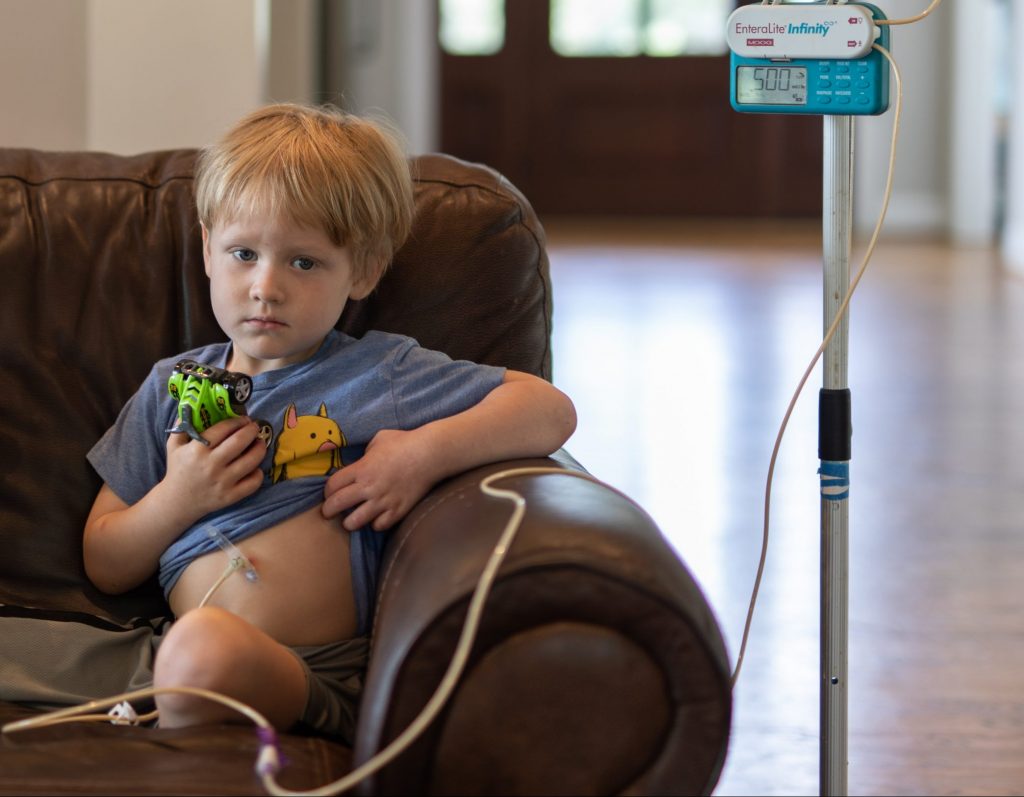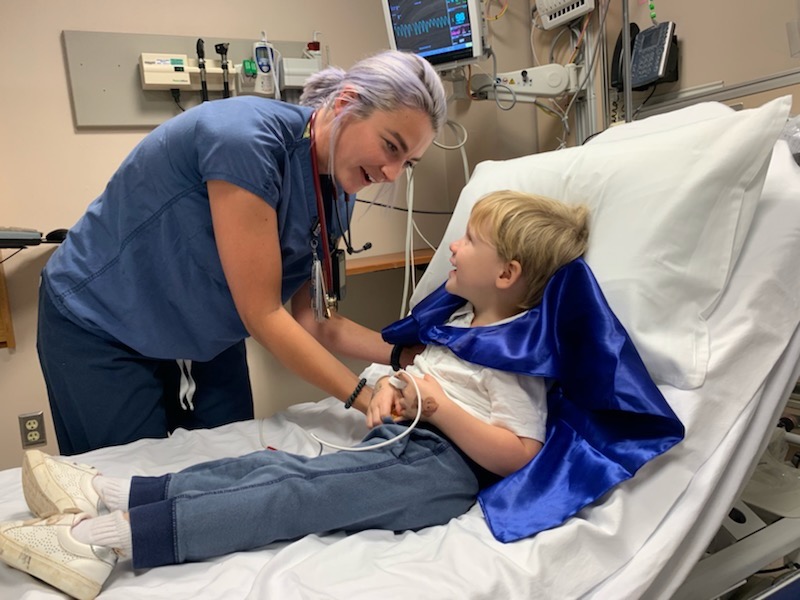When Neal Piper’s 3-year-old son Noah was diagnosed with a rare brain tumor in 2019, the family’s world shrunk.
“Shortly after his birthday … he started choking on his saliva and his food,” says Piper. After a swallow study, balloon surgery, and an MRI, an oncologist told Piper and his wife Valeria that the “MRI shows a large tumor in the base of his skull. The room just shrunk down. And it’s kind of like a Charlie Brown episode where you hear the teacher just mumbling words,” Piper says. “We found out it’s a type of treatable tumor called LCH—Langerhans Cell Histiocytosis.”
Though the prognosis for children with LCH is good, Noah’s family was terrified. “What we learned in that moment is when you have a lot of attention, and a lot of people coming in, that’s never a good sign,” says Piper. “And each morning on rounds, there’d be about 30 people in the hallway talking about how to keep your son alive. He had pneumonia. He was in a sedated coma at that point.”
After making significant improvement, Noah came home from the hospital and continued his treatment. The medical equipment the 3-year-old required to survive included an enteral feeding pump: a gravity-fed device attached to a pole (similar to an IV infusion pump) that allows liquid food to enter the stomach or intestine through a tube.
While the feeding tube was an important part of Noah’s care, the technology was clunky, archaic, and difficult to manage at home. But it was the family’s best option.
“This is the standard of care. It’s over a decade old technology, and there’s millions of people around the world that use this type of technology every day,” says Piper. “You’re connected to this pole [up to] 24 hours a day depending on your need, and so children and adults are walking around the house like this. … Noah, he’s much smaller, and the tubing setup was longer, so he tripped over this several times, and it can rip out a gastrostomy button and be an emergency procedure.”
Rather than continue to watch his son struggle with the technology meant to help him, Piper decided to take action: In March of 2020, he founded a medical device company he called Luminoah, named for his son and his experience during chemotherapy.

At UVA Health’s Battle Building, home to pediatric clinics and outpatient services, Piper says a painting of a spaceship is near the bell children can ring on their last day of chemotherapy. That image inspired Noah, and led to father-son discussions about space. “I merged lumination, the measure of light, with Noah, and shortened that to Luminoah to create a brighter future for people requiring tube feeding,” he says.
Though Noah’s experience with enteral feeding was the original inspiration for the company, Piper consulted a number of other patients and providers. He used a user-driven approach—“We don’t want to assume our use case was the use case of many,” he says—and interviewed dozens of patients, providers, and distributors to learn what the key problems were with current enteral feeding technology.
For many interviewees, issues with tube feeding systems boiled down to lack of mobility, difficulty of use, and trouble tracking nutrition. While the IV-mounted nutrition system can work well in a hospital setting, features like blaring alarms and notifications—perfect for grabbing the attention of staff—often don’t translate well for home use.
Taking all of this into account, the Luminoah team started designing, and made their first prototype in December 2021. Rather than hanging on an IV pole, Luminoah’s device uses a motor to provide nutrition, all at a size smaller than an iPhone in width and height.
“It’s a very familiar user interface for anyone that has a modern day smartphone,” says Piper. “You swipe to open, adjust your feed, press start. You can see the motor turning, priming, and then once you start, you can see the progress. And so you would just click [the nutrition packet] in, put the pouch in your pocket, click on or attach to your stomach, press start, and go.”
According to Dr. William Petersen, Luminoah’s device could significantly improve patient care. “I think this has the potential to revolutionize home feeding,” he says. “The way we currently do home tube feeding is just outdated and it’s been in need of innovation and disruption.”
As a pediatric hematologist oncologist, Petersen says Luminoah would be especially useful in simplifying care for his patients and their families. “Luminoah’s device is small and discreet and portable. It can literally clip to the belt area or shorts or pants, even a small kid’s,” he says. By ditching the IV pole, Luminoah makes it easier for children with feeding tubes to move.
The device’s small size makes it not only portable, but more discreet, giving patients more control over privacy. “I’ve got the device on now, and I could be walking around and no one knows it,” says Piper.
On top of improving patients’ quality of life, Petersen says Luminoah’s metrics help with quality of care thanks to its ability to accurately measure a patient’s nutrition, hydration, and activity levels. “That’s a really important thing, especially for small kids who are struggling with weight gain,” he says. “It’s really important to know exactly how many calories they’re getting, to actually provide that information in a much more accurate and reliable way than our current technology.”
“Our goal is that a young individual could feed themselves, and mom and dad will get an alert saying your child just started a feed, and that you can have full access to the data,” says Piper.

Beyond his own field, Petersen is optimistic about how Luminoah will impact the future of tube feeding. “It is absolutely an area that needs innovation and technological advancement,” he says. In particular, Petersen believes Piper’s personal experience with the limitations of the current technology is a boon to the company. “Luminoah is well positioned and poised to be the company that brings this aspect of patient care forward in a really meaningful and significant way.”
While Luminoah is still working toward FDA clearance (the company is approaching a design freeze, and thinks the device could be approved by 2024), it has made major strides in recent months. In June, it secured $6 million in funding, including contributions from local and state angel investor groups and innovation partners. With this money, Piper says Luminoah will continue to scale up its team and external partners.
After receiving support from local groups like CvilleBioHub, Piper says he is committed to basing his executive team out of Charlottesville. “I think it would have been impossible if we didn’t grow it here,” he says. “There’s something about this region, that it’s small enough that people are connected and willing to connect you to their networks, and support people and ideas. And it’s not like that in every market where you’ve got this competitive sense.”
According to Piper, there are more than 300 disease states that require enteral nutrition. “It’s a $12 billion global market—$4 billion here in the U.S.—and a half a million new patients every year that need this technology,” he says. To meet as many people’s needs as possible, Luminoah is working on a modular system for its device.
Now cancer free, Noah remains a pivotal part of Luminoah. “Initially he got a business card … I think he was Chief of Insights,” says Piper. “He’s no longer [using a] feeding tube and no longer has a port, which is really amazing. So my hope is he’ll never need this device.”
Still, Noah’s—and his twin sister Safi’s—influence on the company fuels their father’s passion for the project.
“There’s a very strong ‘why,’ why we do this every single day,” says Piper. “Really what we’re all about is sunny days ahead and [creating] a brighter future for people.”
